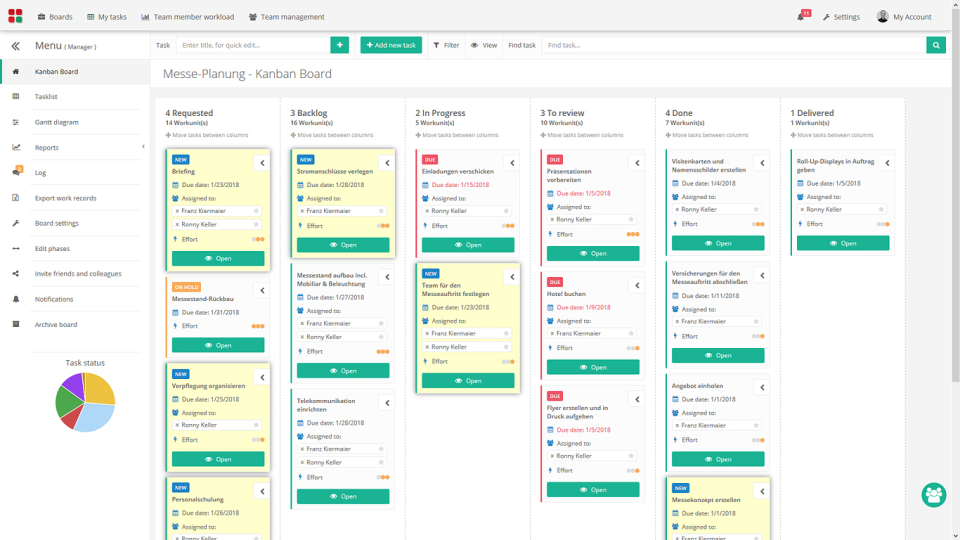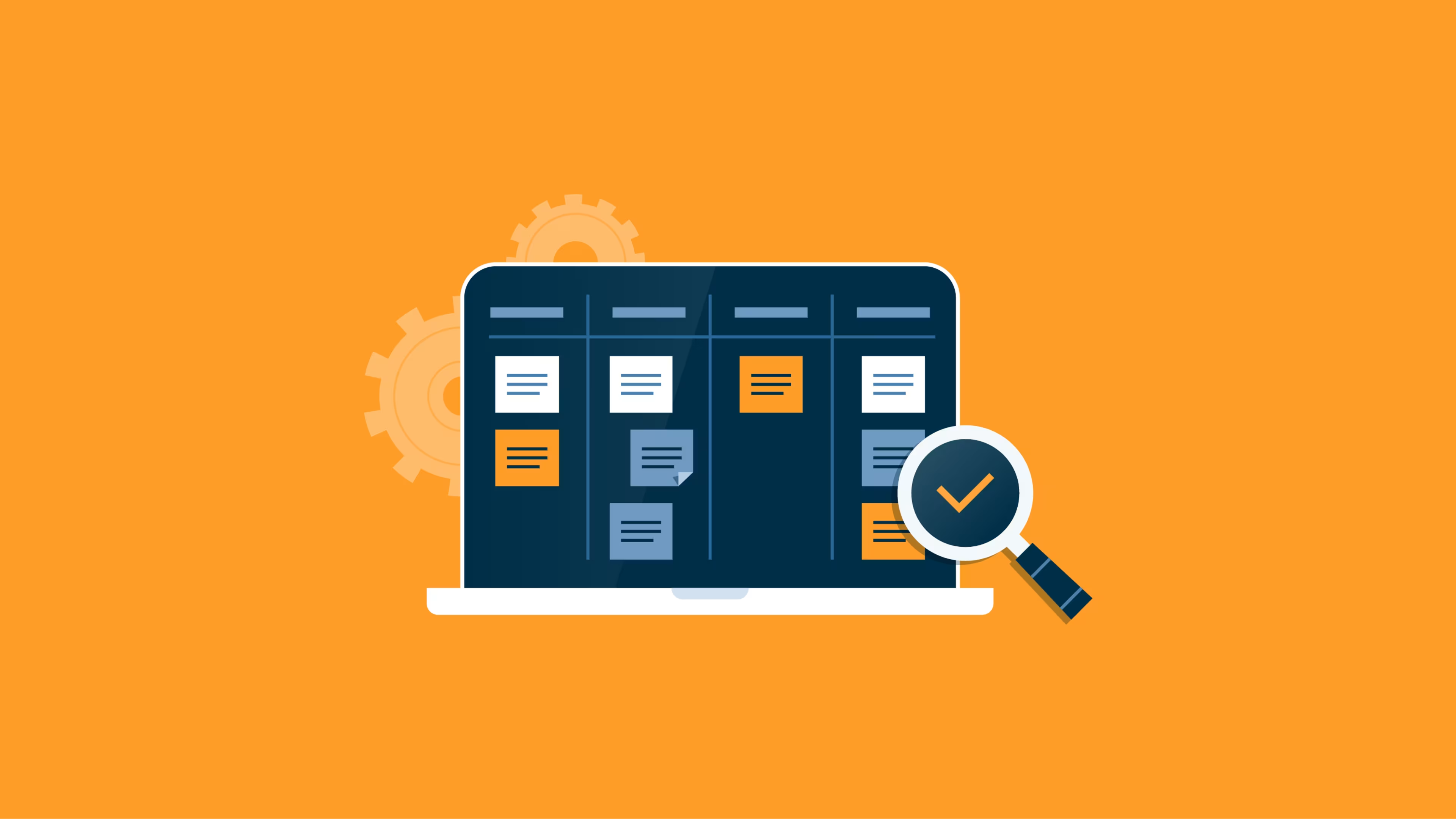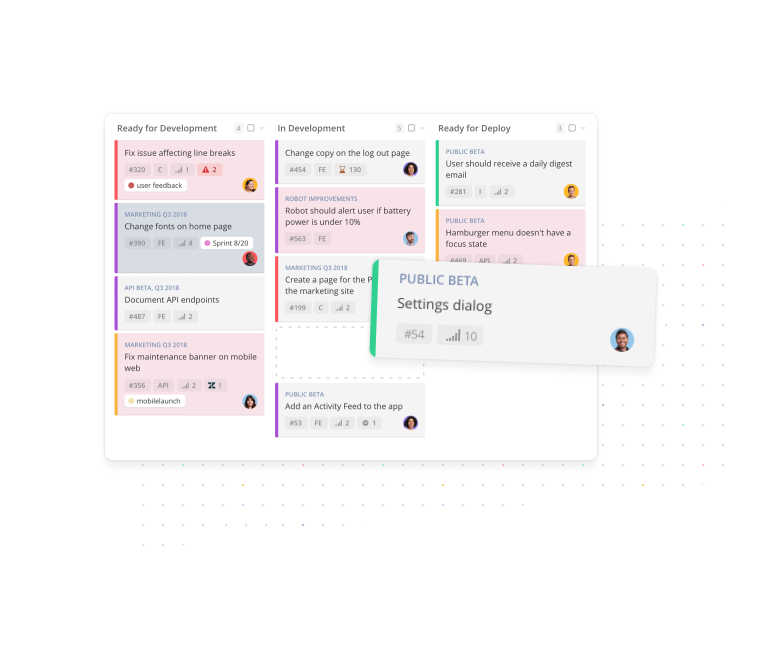Kanban is a popular project management methodology that can help you optimize your workflow.
If you and your team receive a lot of incoming work requests varying in priority and scale, Kanban, which is one of the most popular Agile project management methodologies, may fit your needs. It is a flexible, scalable, and easy-to-use framework that can help you and your team deliver quality products and services to your customers.
Because this framework is based on the principle of continuous improvement and incremental change, it can help you and your team identify, track, and prioritize work items and improve workflow efficiency. In this article, we’ll dive into the key elements of the Kanban methodology and underlying philosophy, and explain why it can be an effective type of project management for the right business.
What is Kanban?
Kanban is a Japanese word meaning "billboard" or "sign." The Kanban methodology for business was developed in the late 1940s by Taiichi Ohno, an industrial engineer at Toyota.
As Ohno's methodology became more popular, project managers from different industries tried to apply its core teachings to their work.
How does Kanban work?
You can use Kanban with any existing workflow or create a new workflow from scratch, creating a Kanban board as the central visualization and collaboration tool for your team.
What is a Kanban board?
To start working with Kanban, you need to create a Kanban board, which is a physical or digital board containing columns and rows.
Each column on the board represents a step in the work process, and each row represents a specific task. Tasks are moved from left to right as they are completed.
There are a few different ways to set up Kanban boards, but the most common way is to use three columns:
To do
In progress
Done
Every task that needs to be completed is added to the “to do” column, and as work on that task is started, it is moved to the “in progress” column.
Once the task is completed, it is moved to the “done” column. This simple system can help your team see what needs to be done, what is being worked on, and what has already been completed. It can also help identify areas where work is getting stuck so you can take steps to unstick it.
Stage 1 – “To Do”
At the beginning of any task, i.e., during the "To Do" stage, it is important that you identify any needed resources, create a timeline, and plan out what needs to be done to work on the task before moving on to the next stage.
Stage 2 – “In Progress”
During the "In Progress" stage, you can see how the task begins to come to fruition. It is important to monitor progress and make any necessary adjustments to ensure the project is successful. Communication between stakeholders is also important to keep the creation process on track.
Stage 3 – “Done”
Once the project is complete and all the required tasks are fulfilled, the "Done" stage is reached. It is important to take a moment to review the overall process and what was accomplished to ensure the best outcome was reached.
Kanban principles
Kanban aims to keep things flexible and visible for you and your team. There are four core principles to follow when you apply the Kanban methodology in your organization:
1. Start with existing workflows
Using Kanban principles to improve existing workflows starts with understanding the current state of the workflow and identifying areas for improvement. Once you have identified areas of improvement, you can use Kanban to optimize the workflow by adding tasks to the Kanban board.
2. Limit existing tasks
Kanban helps you limit existing tasks by allowing you to visualize your work and by providing a way to limit the amount of work in progress.
When you create a Kanban board, you can see at a glance what tasks need to be done and what tasks are currently being worked on.
This helps you prioritize your work and limit the amount of work you take on at any point in time. Limiting the amount of work in progress can prevent employees from getting overwhelmed and ensure that all of your tasks are completed in a timely manner.
3. Respect current processes and roles
Kanban is an effective tool that allows you to respect your current organizational process and existing team roles by providing a framework for understanding and managing work.
You will need to decide how work needs to be done, who is responsible for it, and the expectations for each role. Kanban principles also provide a mechanism for tracking work so that everyone knows what is happening with a specific piece of work and can see where it is in the process.
4. Encourage leadership, creativity, and collaboration
Kanban helps encourage leadership by enabling individuals to see the big picture and identify areas that need improvement. It also allows for creativity by providing a space to brainstorm new ideas and solutions.
It encourages collaboration by allowing team members to see each other's work and progress, which can help facilitate open communication and understanding.
Kanban Values
The Kanban system is based on a number of core values[1].
Transparency
Transparency is a critical value in Kanban, which implies that all members of the team should be informed of any changes, decisions, and progress made in the project. Furthermore, it is important to remain transparent throughout the entire development process so that people understand how things are progressing, find answers quickly, and collaborate better.
Collaboration
Collaboration is an integral part of any Kanban team. Collaboration helps team members understand what the other team members are doing, brainstorm ideas, and work together to find better solutions to problems. It also encourages creativity, communication, and the ability to learn from each other. Collaboration encourages all team members to take responsibility for the project's success and be accountable for the results.
Customer focus
Customer focus implies that team members should always focus on understanding the customer's needs and creating a product that addresses those needs. It will help ensure that the product is of high quality and that the customer is satisfied with the result.
Agreement
Using Kanban, the team should agree on how they will work together. This agreement should include the tasks the team will work on, the timeline for when tasks should be completed, and what duties each team member is responsible for. A clear agreement on the team's workflow can help ensure that the project is completed effectively and efficiently.
Leadership
A key value of Kanban is leadership, meaning the team should have a leader responsible for ensuring that the team works together to achieve the project goals. This leader should be a source of guidance, support, and motivation for the team and should facilitate an effective collective effort. In addition, the leader should encourage team members to ask questions, communicate ideas, and openly share concerns.
Workflow
A Kanban project should be organized so that the team can see the progress of the workflow at any given point in time. It includes understanding the tasks that need to be completed, the team members assigned to each task, the timeline for completing each task, and the resources needed to complete the task. A clear understanding of the workflow helps the team stay on track and work more efficiently.
Understanding
The value of understanding encourages team members to be supportive of each other and work together to achieve the best outcomes. Understanding also means that there needs to be a good level of communication between team members, with everyone understanding the goals of the project and their role in it.
Respect
Team members should be respectful of each other, their assigned tasks, and the timeline for when they should be completed. A successful Kanban team should always strive for respect and mutual understanding between team members. Respect also means that team members should always be willing to listen to the ideas and opinions of their colleagues, which could lead to better solutions and improved outcomes for the team.
Balance
This value of balance implies that the workload should be distributed evenly among the team members, and no team member should have too much or too little work assigned. By ensuring that the workload is spread out, the team should be able to work more efficiently and effectively.
Benefits of Kanban
If you decide to implement the Kanban methodology as your preferred Agile project management framework, you and your team can benefit in these ways:
Increased efficiency and productivity: Kanban practices help you identify and eliminate bottlenecks in the system and increase efficiency and productivity. This is achieved by providing teams with visualized workflows, enabling them to recognize and remove any obstacles to productivity.
Higher quality: Kanban's focus on continuous improvement and flow can help you achieve a higher quality of work.
More transparency: You can create more transparency for yourself and your team by visualizing tasks on the Kanban board for everyone on your team to see.
Better communication and collaboration: Kanban helps streamline communication and collaboration between team members, enabling them to plan, prioritize, and organize their tasks in an effective and efficient manner.
Scrum vs. Kanban
Scrum vs. Kanban can sometimes be seen as a sort of ideological fight for Agile project managers.
Scrum is an Agile framework that prescribes a specific way of working, with strict roles and responsibilities and clear guidelines for each phase of the project. This can be beneficial in ensuring that everyone is on the same page and that the project progresses smoothly. However, it can also be inflexible and difficult to change in the middle of a project if needed.
On the other hand, the Kanban methodology is a more flexible system that relies on visual cues to track progress and identify areas that need attention. A Kanban board enables teams to quickly and easily adapt to changing situations by visually organizing tasks and assigning priority. As a result, it can make it easier to adapt and make changes as needed.
However, staying organized and focused can also be easier with a prescribed framework such as Scrum.
Ultimately, it's up to you to decide which approach is best for your project. For example, if you need a more structured and predictable approach, Scrum may be the way to go. But if you need more flexibility and are willing to experiment a bit, Kanban could be the better option.

Kanban board in Agile Kanban (Source)
What is the difference between Kanban and Agile?
Whether Kanban is essentially a subset of Agile is an ongoing discussion in the Agile community. Kanban and Agile project management frameworks are both used to help organize and track the progress of projects effectively.
Agile is an iterative project management process based on incremental changes, meaning that projects are broken down into small manageable chunks and then tested, modified, and improved over time to reach the final goal. It relies heavily on customer feedback and collaboration with the team to succeed.
Kanban includes some of these Agile workflow dynamics; however, its main benefit is the visual process for managing projects using a Kanban board.
Project management software that supports Kanban
Discover project management software that supports the Kanban methodology to help you and your team deliver quality products and services to your customers.


